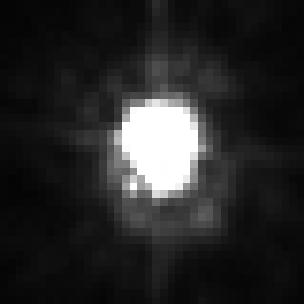Image List
-

There is more to Polaris than meets the eye - two faint stellar companions. The North Star is actually a triple star system. And while one companion (at top in this artist's concept) can be seen easily through small telescopes, the other hugs Polaris so tightly that it has never been seen directly - until now. By stretching the capabilities of NASA's Hubble Space Telescope to the limit, Smithsonian astronomer Nancy Evans and her colleagues have photographed the close companion of Polaris (seen here just above bright Polaris itself) for the first time. (Image not to scale.)
Greg Bacon (STScI) -

The faint companion to Polaris is clearly visible at the 7 o'clock position in this image from NASA's Hubble. It is located less than two-tenths of an arcsecond from Polaris.
NASA / STScI / N. Evans (CfA)